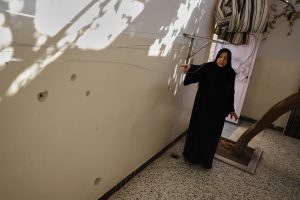What Palestinians stand to gain and lose from Trump’s peace proposal

On Monday, President Donald Trump and Israeli Prime Minister Benjamin Netanyahu held a press conference at the White House, detailing a proposed plan to bring Israel’s war in Gaza to a close. While the Israelis have all but agreed to the proposal, Hamas said they haven’t seen the entirety of it, and thus haven’t committed to its terms nor commented on it.
“While we’ve been anticipating the content of the initiative for a few days now, the specifics are complex and have many, many ramifications,” said Karim Mattar, an associate professor at the University of Colorado Boulder. “First and foremost, whether Hamas will be able to accept their extinction as a political force.”
What does the plan include?
Among the provisions in the agreement are an immediate ceasefire, the release of the remaining hostages in Hamas’ captivity, a phased withdrawal of the Israeli military from Gaza, and an international “stabilization force” to ensure Palestinians’ security in Gaza and oversee the disarmament of Hamas.
The plan also calls for Hamas to relinquish its role in Gaza’s government. Gaza will be governed in two tiers, with an international body overseeing a Palestinian committee. Similarly, the proposal states there would be no more forced displacement of Palestinians from Gaza, paving the way for a potential Palestinian state, while the United Nations would also provide humanitarian aid.
What does the plan mean for Palestinians?
Hilary Falb Kalisman, an associate professor at the University of Colorado Boulder, told Straight Arrow News that a stronger international presence –– from aid distribution to peacekeeping –– could be good for Palestinians living in Gaza.
“The fact that international organizations would be permitted to distribute aid is good for Palestinians, after the disaster of the Gaza Humanitarian Foundation. An international force might also offer Palestinians some additional protections which were impossible since Oct. 7,” Kalisman said. “Ending the fighting, withdrawing Israeli troops and allowing in aid would be good for Palestinians, and indeed for Israelis, particularly as the plan requires the release of the hostages.”
However, Kalisman noted that regardless of Gaza’s political makeup moving forward, Palestinians have little to no agency in their own affairs.
“One thing to keep in mind is that Palestinians aren’t being given a choice in the matter of how they are governed,” Kalisman told SAN. “The technocratic, apolitical committee meant to govern Gaza according to this proposal isn’t an elected one.”
At one time, both Gaza and the West Bank were run by the Palestinian Authority. However, the governing body lost control of Gaza to Hamas in 2007 after Palestinians voted them into the majority in their Legislative Council a year prior. Meanwhile, roughly 60% of the West Bank is under Israeli control.
In 2020, during Trump’s first administration, an Israeli-Palestinian peace proposal was put forth, which would’ve required the Palestinian Authority to recognize Israeli settlements in the West Bank as legitimate.
Five years later, Trump’s new proposal again disregards the Palestinian Authority’s right to govern Gaza or the West Bank.
“As the proposal is written, there is no real place for the Palestinian Authority in the future government of Gaza without accepting Trump’s 2020 peace plan,” Kalisman said. “The plan itself wasn’t viewed as producing an economically viable Palestinian state at the time, and many criticisms of it have focused on the annexation of different areas within the West Bank.”
Kalisman added that Netanyahu has made it explicitly clear that he does not support a Palestinian Authority government operating in the region.
Whether the Palestinian Authority wants sole control of Palestinian territories or not, the sheer level of devastation across Gaza will necessitate at least some external support.
Hamas’ disarmament
Meanwhile, the Trump proposal also requires Hamas to completely disarm –– something the militant organization has refused to do, and which they are “very unlikely to see as a positive,” according to Kalisman.
However, the proposal is not a zero-sum game.
“Some aspects of the agreement are likely to go through even without Hamas’ agreement, including the withdrawal of Israeli troops from certain areas of Gaza in favor of an International Stabilization Force,” said Kalisman.
The post What Palestinians stand to gain and lose from Trump’s peace proposal appeared first on Straight Arrow News.





